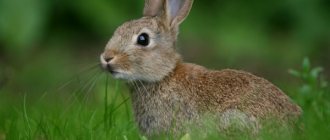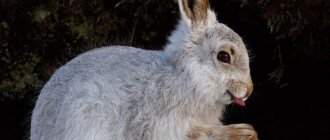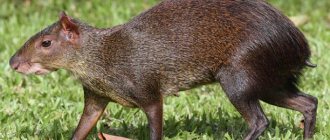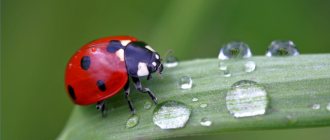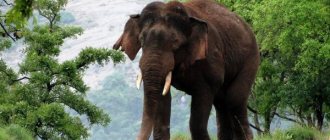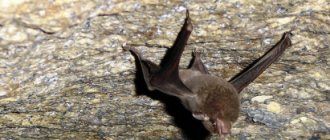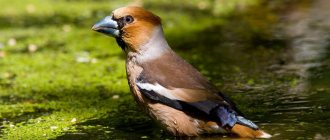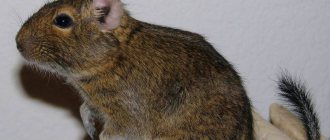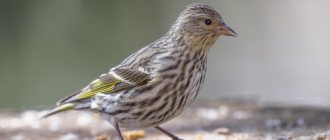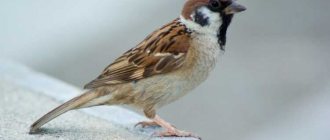Hares are perhaps the most common animals in our country. Despite the fact that they are a favorite trophy of many hunters, their numbers are practically unchanged, since due to their fertility, these animals reproduce very actively.
There are about 30 species in total; all types of hares differ somewhat in external features and habits.
Appearance
If we take a general description of the hare (mammal, hare family), we should note similar features in all species:
- long ears;
- underdeveloped collarbones;
- long and strong hind legs;
- short fluffy tail.
Females are larger than males, the size of animals ranges from 25 to 74 cm, and weight reaches 10 kg.
Thanks to its long hind legs, this animal is able to run fast and jump. The running speed of a brown hare, for example, can reach 70 km/h.
Shedding
These animals molt twice a year, in autumn and spring. The beginning and timing of molting are related to external conditions. Molting begins when the length of daylight changes, and its duration is determined by air temperature.
Spring molting in most species begins in late winter - early spring and lasts on average 75-80 days. The animal begins to shed from the head to the lower extremities.
Autumn molting, on the contrary, begins from the back of the body and moves to the head. It usually begins in September, and molting ends by the end of November. Winter fur grows thicker and more lush, it protects the animal from the cold.
Habitat - where it lives
Both hare and hare are predominantly found in forest and steppe areas.
White hare
Habitat of the mountain hare
The mountain hare can be found in tundra, forest and forest-steppe zones throughout the northern part of the Eurasian continent. In Russia it lives almost everywhere. The most attractive for hare are forests interspersed with meadows and river valleys.
Brown hare
Habitat of the brown hare
The habitat of the brown hare is the regions of Europe, Asia and North Africa, as well as the European part of Russia. He prefers to live in open spaces of steppes and forest-steppes, as well as in meadows, fields, forest edges and extensive clearings.
Interesting fact : in the Americas, New Zealand and Australia, the brown hare was artificially populated, and in the latter, reproducing uncontrollably due to the lack of predators, it turned into a dangerous pest that has a devastating impact on nature.
Varieties
There are four common species in Russia: the Manchurian hare, the sandstone hare, the white hare and the brown hare. Let's look at them in more detail.
Manchurian
This species has much in common with the wild rabbit, but it is still difficult to confuse them, since the Manchurian hare looks somewhat different.
This is a small animal no more than 55 cm long and weighing up to 2.5 kg. The length of the ears is about 8 cm. The fur is hard and thick, brownish-ochre in color. The belly and sides are lighter than the body; there are several dark stripes on the back.
The habitat of this species is the Far East, the Korean Peninsula and Northeast China. In cold weather, this species experiences seasonal migration over short distances, during which animals move to places where there is less snow.
In nature, the species is not very widespread and has no commercial significance.
Sandstone
This species is also called tolai or talai. Compared to the Russians, it is quite small. Length 40-55 cm, weight up to 2.5 kg. But the tail and ears are longer: the length of the tail reaches 11.5 cm, the ears - up to 12 cm. Narrow paws are not adapted to move on snow. In summer, this species has grayish-buff fur, white on the throat and belly, and always remains dark on the rest of the body. The molting period largely depends on the habitat and weather conditions.
Tolai chooses flat areas, deserts and semi-deserts for life, but sometimes climbs high into the mountains. In Central Asia it can be found at an altitude of 3000 m above sea level. Often this hare lives in a hole abandoned by another animal; it rarely digs holes itself.
Tolai leads a sedentary life and migrates only in case of severe deterioration in weather conditions or when there is an acute lack of food.
This species reproduces less frequently than others - 1-2 times a year, but since it is not hunted often, a decrease in numbers is not observed.
Tolay is widespread in Central Asia. It is also found in Transbaikalia, Mongolia, Southern Siberia and some provinces of China. In Russia, the tolai lives in Altai, the Astrakhan region, Buryatia and the Chui steppe.
Belyak
Description of the hare: this is a fairly large representative of the hare family. How much does a hare weigh? The average weight of a white hare is 2-3 kg, and can reach up to 4.5 kg. Body length is from 45 to 70 cm, ears – 8-10 cm, tail – 5-10 cm. This species has wide paws. Thanks to its feet covered with thick hair, the hare moves easily even on loose snow in winter. The color depends on the time of year. In summer, the skin is gray - dark or with a reddish tint, with brown spots. The head is darker than the body, the belly is white. In winter, the white hare's skin becomes pure white. She sheds twice a year, in autumn and spring.
Where does the white hare live? In Russia, the white hare inhabits most of the territory from western Transbaikalia and the upper Don to the tundra. Large populations of this species also live in China, Japan, Mongolia, South America and Northern Europe.
For life, they choose small forests located near water bodies, farmland and open spaces, places rich in herbaceous plants and berries. They lead a sedentary lifestyle, occupying an area of 3 to 30 hectares, migrating only in case of severe bad weather and lack of food supply. Long-distance and mass migrations of the hare are observed only in the tundra zone, where the snow cover in winter is so high that the hare’s food (low-growing plants) becomes inaccessible.
They breed 2-3 times a year, and there are up to 11 hares in a litter. The lifespan of a hare in the wild is from 7 to 17 years.
Hare
The brown hare is larger than the hare. With a body length of 57-68 cm, it weighs from 4 to 7 kg. The length of the ears is 9-14 cm, the tail of the hare is 7-14 cm. The hare has longer and narrower paws than the hare.
This hare is gray in summer with an ocher, brownish or reddish tint. In winter, the gray hare living in the middle zone practically does not change its color, only becoming a little lighter. Animals inhabiting the northern regions become almost white, leaving only a dark stripe on the back.
Where does the brown hare live? In Russia, Russians inhabit the entire European part, the region of the Ural Mountains, in Southern Siberia, the Khabarovsk Territory and territories near Kazakhstan, in Transcaucasia in the Caucasus and Crimea.
Brown hare populations also inhabit Europe, the USA, Canada, Asia Minor and Asia Minor.
What does the hare eat? Since it is a herbivore, its diet consists of green parts of plants: clover, dandelion, mouse peas, yarrow, and cereals.
The brown hare is a steppe hare; it chooses open spaces to live; it rarely lives in forest areas and in the mountains. The animals lead a sedentary life, occupying an area of 30 to 50 hectares. Seasonal migrations occur only among Russians living in mountainous areas. The brown hare descends from the mountains in winter, and climbs back to higher ground in summer.
They reproduce depending on the habitat and weather conditions, from 1 to 5 times a year. There are 1 to 9 hares in a litter. How many years does a hare live? The average life expectancy of a hare is 6-7 years.
Key Similarities
The main criteria by which one can confuse a white hare and a brown hare:
- They both belong to the same genus of hares;
- They lead a predominantly sedentary lifestyle;
- They have a similar fur color in the summer.
- They eat only plant foods;
- They do not stockpile food during the winter.
In other parameters, the brown hare and the white hare have distinctive features.
Lifestyle and habits
This long-eared animal leads a twilight-nocturnal lifestyle. During the day, the animal rests on ditches. True, in places where there is a high number of obliques, the habits of the hare change and, often, it is active during the day.
Unlike rabbits, the scythe does not dig deep holes. A hare hole is a small depression in the ground, under bushes or tree roots. These animals choose their beds depending on the terrain and weather conditions. In warm, clear weather, they can roost almost anywhere if there is at least a small shelter nearby. In winter, finding places to lie down is not a problem at all, since hares sleep right in the snow.
The oblique runs very fast, while running it often makes long jumps and can suddenly change direction. This method of movement helps the animal escape from the predators pursuing it. Eared cunning creatures are excellent at confusing their tracks. At the slightest threat, the animal freezes motionless until it considers that nothing threatens it anymore.
Many people wonder if hares can swim. Although they do not like water and try to stay away from it, they swim well.
This is a practically voiceless animal; even during the mating season they behave silently, only occasionally voicing. And only the wounded hare emits a loud cry, reminiscent of the cry of a baby.
Nutrition
The diet of the oblique is very varied. What a hare eats depends on the season, weather conditions and habitat.
In summer
In summer, this herbivorous animal eats more than 500 species of plants, preferring their green parts. Also loves to eat melons, vegetables and fruits. Animals often get out into the fields and raid vegetable gardens and orchards. In autumn, their diet includes more and more solid food. Withered grass, roots and branches of bushes become their main food.
in winter
What do hares eat in winter, when there is no greenery?
The thicker the layer of snow, the harder it is for the long-eared animal to obtain food. High snow levels can hide almost everything that hares eat in winter. Animals escape from hunger by moving closer to populated areas. They are helped out in harsh winters by haystacks, frozen berries on bushes, and fallen fruits that the animals dig out from under the snow.
Tree bark makes up the majority of the diet during the cold season. Usually the scythe selects soft trees: aspen, birch, willow and others.
in spring
In spring, the diet becomes significantly more varied due to buds, young shoots and fresh grass. To compensate for the nutritional deficiency, the long-eared eats pebbles, soil and even animal bones.
How do hares prepare for winter?
As a rule, before winter, hares begin to become pubescent. Their fur becomes denser and serves to protect them from the cold. The white hare changes color from gray to snow-white.
In very cold weather, they can dig holes in the snow, up to 2 meters deep, and sit there for whole days, waiting out the frosts. And as soon as it gets warmer, the hares run to the open area, to where the first grass appears. Hares do not stock up on food for the winter, pinning their hopes on luck. They can even dig holes in haystacks.
Reproduction
The weather conditions directly determine when the hares begin mating. In warm winters, the rut can begin in January, and after frosty winters - in early March.
During the mating season, these animals communicate by tapping a certain rhythm on the ground with their front paws. Males compete for the attention of females, engaging in spectacular fights.
Young individuals are ready for reproduction at the age of one year. Most species produce offspring several to five times a year, with an average of 2-5 cubs per litter. Despite the fact that the rabbits are born developed and sighted, for the first days they practically do not move, hiding in a hole.
The female leaves the brood almost immediately after giving birth and only occasionally returns to feed the cubs. Since females have offspring at the same time, any hare that comes across hungry cubs will definitely feed them. This behavior is easy to explain. Baby hares have no smell, unlike adults, and the less often the female is near them, the less chance the cubs have of becoming prey to a predator.
Night life
The largest hare in the world prefers to do its business exclusively in the dark, so you can meet it in the light of day only during the breeding season.
The hare is especially active at the beginning and end of the night. If circumstances are not the best, he can sleep for more than one day, remaining without food. In summer, the hare’s “bedroom” is a small hole dug under a fallen tree, in thickets of tall grass, in the shade of a large bush, or in the middle of a field. The hare does not suit himself with permanent housing, because he needs a hole only as a shelter from the scorching summer sun.
Often the largest hare in the world finds shelter in the burrows of its neighbors - foxes, badgers or marmots. The choice of a place for a hare's daytime rest directly depends on the characteristics of the time of year.
With the onset of spring, he chooses places warmed by the still timid rays of the sun, and during floods he prefers higher places.
In winter, the hare finds shelter among the snow covers, hidden from the icy winds. If the depth of the snowdrift is quite large, the hare digs holes up to two meters in length. There are often cases when a hare has an eye for a cozy haystack, prepared by practical villagers for their own purposes.
Hunting
Hare hunting is popular in our country. This animal is an object of fur trade and sport hunting. Large quantities of these animals are hunted for their fur and tasty, nutritious meat.
Hunting begins in October before snowfall and lasts throughout the winter. There are many ways of hunting: by tracking, in blinds, in powder, with dogs and “in the wild”.
The scythe has many enemies in nature besides hunters. It is hunted by birds of prey, wolves, lynxes, coyotes and foxes. High fertility helps these animals maintain their numbers.
The role of the hare in human life
The lifespan of this animal species in the wild is six to seven years. Rarely, but there are exceptions when the hare lives 12 years or more. The brown hare is valuable for its fur and meat, which is why it is included in the list of game animals. The skins are used to produce high-quality felt, and also sew fur products.
But there are many countries where the brown hare is considered a malicious pest of agricultural crops. Indeed, these cute animals harm winter crops and fruit plantings. Hares are capable of eating the entire vegetative part of 15 trees in just one night. In addition to harming agricultural plants, these animals are carriers of diseases such as brucellosis, coccidiosis, tularemia and others that affect humans, and in severe forms.
